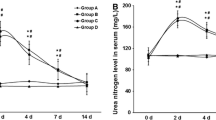Abstract
Complete papillary necrosis in rats can be induced within 1 month following a single injection of 2-bromoethylamine hydrobromide (BEA) (50 mg, i.v.). Utilizing a combination of clearance and balance techniques the effects of complete absence of the papilla was examined as regards urinary acidification, whole kidney glomerular filtration rate (GFR), single nephron GFR, and morphology. Whole kidney GFR was not different from control, however, the percent filtering juxtamedullary nephrons was markedly diminished (87.2±2.1 vs. 31.5±3.6% filtering, control vs. BEA, respectively,P<0.001) and significantly reduced in the superficial nephrons (80.6±3.6 vs. 62.2±6.1% filtering, control vs. BEA, respectively,P<0.05). There was a significant decrease in juxtamedullary single nephron GFR and an increase in the superficial single nephron GFR as assessed by the quantitative Hanssen's technique in the animals with chronic papillary necrosis. Complete papillary necrosis was associated with normal arterial bicarbonate concentration, pH, and plasma electrolyte concentrations. At the same degree of acidemia (induced by NH4Cl administration) minimal urinary pH, ammonium excretion, and titratable acid excretion were not different than seen in age matched controls. The response to Na2SO4 infusion and phosphate infusion was the same in both groups of animals. The urineblood (U-B)pCO2, an index of urinary acidification, was identical in BEA and control animals. Scanning electron microscopy showed scarring of the juxtamedullary glomeruli one month after BEA. The papilla was sloughed and lying free in the renal pelvis in every experimental animal. These data demonstrate that complete papillary necrosis is not associated with acidosis nor a defect in urinary acidification.
Similar content being viewed by others
References
Arruda JAL, Nascimento L, Mehta PK, Rademacher DR, Sehy JT, Westenfelder C, Kurtzman NA (1977) The critical importance of urinary concentrating ability in the generation of urinary carbon dioxide tension. J Clin Invest 60:922–935
Arruda JAL, Sabatini S, Mehta P, Sodhi B, Baranowski RL (1978) Functional characteristics of drug-induced experimental papillary necrosis. Kidney Int 15:264–275
Buerkert J, Martin D, Head M, Prasad J, Klahr S (1978) Deep nephron function after release of unilateral ureteral obstruction in the young rat. J Clin Invest 6:1228–1239
Buerkert J, Martin D (1981) Role of deep nephrons and collecting duct in urine acidification. Kidney Int 19:235
Coelho JB, Chien KCH, Bradley SE (1972) Measurement of single nephron glomerular filtration rate without micropuncture. Am J Physiol 223:832–839
Cunnaro JA, Weiner MW (1974) A comparison of methods for measuring urinary ammonium. Kidney Int 5:303–305
Dach JL, Kurtzman NA (1976) A scanning electron microscopic study of the glycerol model of acute renal failure. Lab Invest 34:406–414
Finkelstein FO, Hayslett JP (1974) Role of the medullary structures in the functional adaptation of renal insufficiency. Kidney Int 6:419–425
Graber ML, Caflisch CR, Bengele HH, Swartz JH, Alexander EA (1980)pH profile along the inner medullary collecting duct of the rat. Clin Res 28:446A
Hanssen OE (1961) The relationship between glomerular filtration and the length of the proximal convoluted tubules in mice. Acta Pathol Microbiol Scand 53:265–279
Hierholzer K (1961) Secretion of potassium and acidification in the collecting duct of the mammalian kidney. Am J Physiol 201 (in press)
Hill GS, Wyllie RG, Miller M, Heptinstall RH (1972) Experimental papillary necrosis of the kidney. II: Electron microscopic and histochemical studies. Am J Pathol 68:213–234
Kurtzman NA (1970) Regulation of renal HCO3 reabsorption by extracellular volume. J Clin Invest 49:586–595
Lanari A, Coelho JB, Aprizujeta EE, Yelinek L, Ruiz-Guinazu A (1966) Concentrating mechanism and glomerular filtration rate in the papillectomized dog kidney. Acta Physiol Lat Am 16:220–226
Martinez-Maldonado M, Opava-Stitzer S (1977) Pathophysiology of clinical disorders of urine concentration and dilution. In: Kurtzman NA, Martinez-Maldonado M (eds) Pathophysiology of the kidney. Charles C Thomas, Springfield, p 992
Martinez-Maldonado M, Opava-Stitzer S (1978) Urine concentration and dilution: Contribution of papillary structures during high rates of urine flow. Kidney Int 13:194–200
Murray G, Wyllie RG, Hill GS, Ramsden PW, Heptinstall RH (1972) Experimental papillary necrosis of the kidney. I: Morphologic and functional data. Am J Pathol 67:285–302
Richardson RMA, Kunau RT (1981) Bicarbonate reabsorption by the rat papillary collecting duct: effect of acetazolamide. Kidney Int 19:254
Sabatini S, Mehta PK, Hayes S, Kurtzman NA, Arruda JAL (1981) Drug induced papillary necrosis: electrolyte excretion and nephron heterogeneity. Am J Physiol 241:F14–22
Tannen RL (1969) The relationship between urine pH and acid excretion. The influence of urine flow rate. J Lab Clin Med 74:757–761
Ullrich KT, Eigler FW (1958) Sekretion von Wasserstoffionen in den Sammelrohren der Säugertierniere. Pflügers Arch 267:491–496
Wilson DR (1972) The effect of papillectomy on renal function in the rat during hydropenia and after an acute saline load. Can J Physiol Pharmacol 50:662–673
Wilson DR (1975) Nephron heterogeneity in the post obstructed kidney. Kidney Int 7:19–26
Author information
Authors and Affiliations
Rights and permissions
About this article
Cite this article
Sabatini, S., Alla, V., Wilson, A. et al. The effects of chronic papillary necrosis on acid excretion. Pflugers Arch. 393, 262–268 (1982). https://doi.org/10.1007/BF00584080
Received:
Accepted:
Issue Date:
DOI: https://doi.org/10.1007/BF00584080




